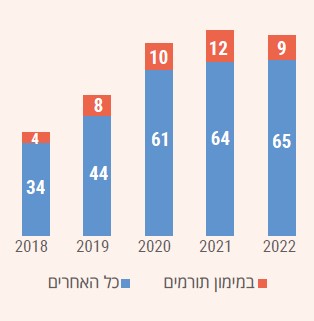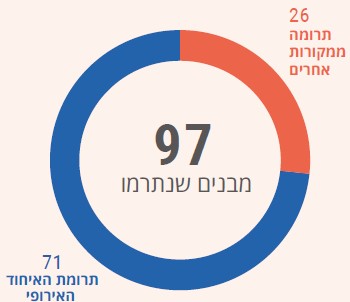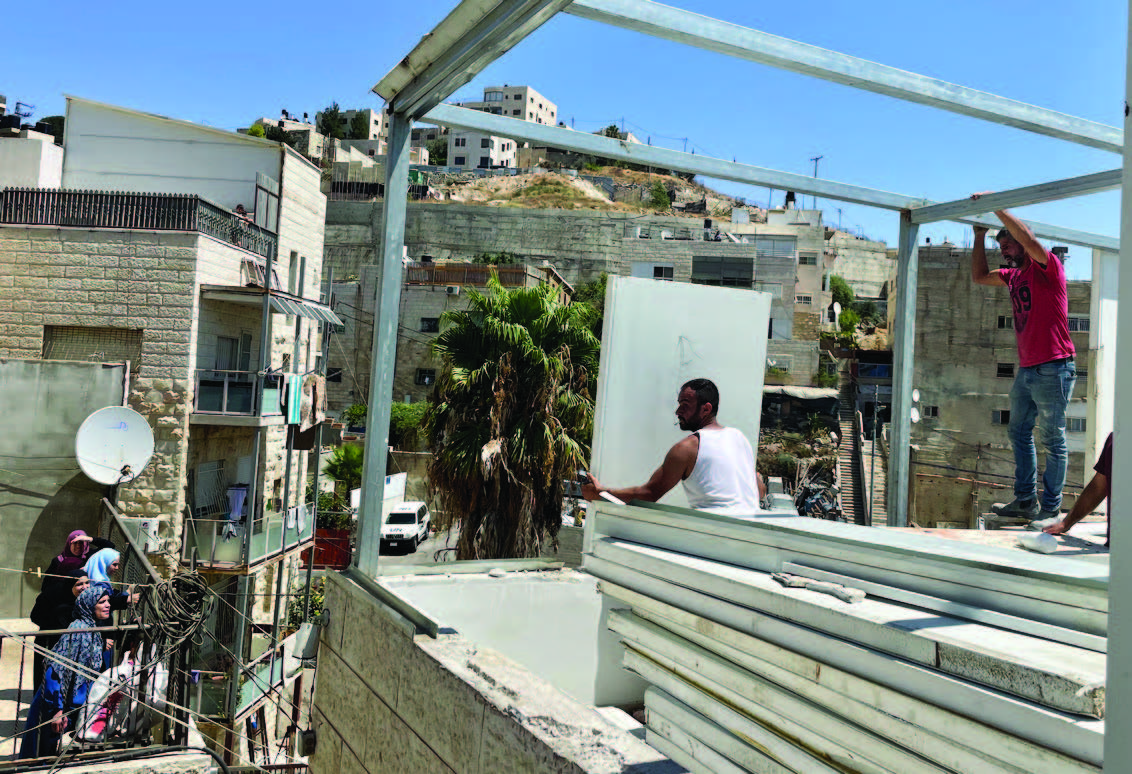הרס מבנים ועקירת בני אדם בגדה המערבית | יולי-אוגוסט 2022
דגשים
- במהלך שמונת החודשים הראשונים של 2022 פחת מספר המבנים שנהרסו או נתפסו (590) ב־3% לעומת שנת 2021, ומספר בני האדם שנותרו מחוסרי בית (707) פחת ב־14%.
- מספר המבנים בבעלות פלסטינית שנהרסו או נתפסו באוגוסט 2022 (134) הוא הנתון החודשי הגבוה ביותר השנה, יותר מכפליים מהממוצע בשבעת החודשים הראשונים של השנה (65).
- מספר המבנים במימון תורמים שנהרסו או נתפסו ביולי ובאוגוסט (24) היה גבוה ב־50% מהממוצע החודשי בששת החודשים הראשונים של 2022.
- שלושה מבנים, בהם שני בתי ספר שנבנו במימון תורמים, מצויים בסכנת הריסה קרובה.
מבנים שנהרסו/נתפסו

נתונים לחודש יולי-אוגוסט
| מבנים | |
|---|---|
| ירושלים המזרחית | 24 |
| שטח C | 167 |
| שטח B | 3 |
| שטח A | 8 |
| בני אדם | |
| נעקרו | 216 |
| נפגעו בדרכים אחרות | 1,230 |
מבנים שנתרמו ונהרסו או נתפסו בשנת 202

סקירה כללית
ביולי ואוגוסט 2022 הרשויות הישראליות הרסו, תפסו או אילצו בני אדם להרוס 202 מבנים בבעלות פלסטינית ברחבי הגדה המערבית, לרבות ירושלים המזרחית, ש־29 מתוכם ניתנו כסיוע הומניטרי במימון תורמים. הריסות אלה הותירו 216 בני אדם, בהם 105 ילדים, מחוסרי בית ופגעו באופנים אחרים במחייה או בגישה לשירותים של יותר מ־1,200 בני אדם נוספים. כל המבנים מלבד 14 נבחרו להריסה או לתפיסה בנימוק של היעדר היתרי בנייה, שלפלסטינים כמעט בלתי אפשרי להשיגם.
12 מהמבנים שנהרסו או נתפסו ביולי ובאוגוסט היו בקהילות רועים השוכנות בשטחים שהוגדרו על ידי ישראל כ"שטחי אש". כמעט 30% משטח C מוגדרים כ"שטחי אש" ו־38 הקהילות הפלסטיניות בשטחי אימונים אלה נמנות עם החלשות והפגיעות ביותר בגדה המערבית, וסובלות מגישה מוגבלת לשירותים חיוניים ולתשתית בסיסית. בקהילות הרועים אל־ג׳יפתליכ אבו שוּנֶה ופסאיל, שתיהן בנפת יריחו, הרסו הרשויות הישראליות שמונה מבנים, ששישה מתוכם ניתנו כסיוע הומניטרי, במענה על הריסות קודמות. 14 בני אדם נותרו בלא קורת גג ושבעה בני אדם אחרים נפגעו באופנים אחרים. בנוסף, בקהילות אל־עביידיה ואום קוסא, שתיהן בדרום נפת חברון, ובח׳רבת ראס אל־אחמר שבנפת טובאס הרסו הרשויות הישראליות ארבעה מבנים בסך הכול. הריסות אלה הותירו 23 בני אדם, 17 מהם ילדים, ללא קורת גג.
ביולי ובאוגוסט, 27 מבנים בשטח C נתפסו בלא התראה, נוהל שמנע מהבעלים את האפשרות לקבול על תפיסתם. נתון זה משקף ירידה משמעותית בשימוש בנוהל זה, בהשוואה לממוצע החודשי של מבנים שנתפסו בשנת 2021 כולה (35).
בנוסף, בשש תקריות נפרדות בקהילות בשטח C – אל־עביידיה, אום קוסה ואל־ג׳וואיה (כולן בנפת חברון) וא־סאווייה וחווארה (שתיהן בנפת שכם) – הרשויות הישראליות הרסו בסך הכול תשעה מבנים על סמך צוו צבאי 1797, המתיר הריסה או תפיסה של מבנה תוך 96 שעות ממתן הצו, ומגביל מאוד את העילות לערעור על הריסה בבתי משפט. הריסות אלה הותירו שישה משקי בית המונים 26 בני אדם, בהם עשרה ילדים, ללא קורת גג. מאז נכנס לתוקף ביולי 2019 נהרסו על סמך צו זה סך של 210 מבנים בבעלות פלסטינית.

משפחה פלסטינית נאלצה להרוס את ביתה בראס אל עמוד, מזרח ירושלים. 24 באוגוסט © .2022 צילום: משרד האו״ם לתיאום עניינים הומניטריים
עדיין קיים חשש כבד לשלומם של עשרות אלפי פלסטינים החיים בפחד ובחוסר ביטחון בשל צווי הריסה תלויים ועומדים העלולים להיות מיושמים בכל זמן נתון. ביוני 2022 נרשם שיא במספר צווי ההריסה שניתנו בחודש יחיד נגד מבנים במימון תורמים – 55 מבנים כאלה בסך הכול הוצבו בסכנת הריסה. בנוסף על הגידול במספר צווי ההריסה והפסקת העבודה שניתנו נגד מבנים בבעלות פלסטינית, נצפתה גם עלייה בולטת בתפיסה של כלי רכב, טרקטורים, מכלי מים ופריטים אחרים שהם חיוניים לקיומן של הקהילות החיות בשטח C.
במהלך שמונת החודשים הראשונים של 2022 נהרסו ונתפסו בסך הכול 590 מבנים ו־707 בני אדם נותרו ללא קורת גג. המניין החודשי של מבנים שנהרסו או נתפסו ירד ב־3% לעומת הממוצע החודשי לשנת 2021, שבה נהרסו 911 מבנים; גם המניין החודשי של בני אדם שנותרו ללא קורת גג פחת ב־13% לעומת הממוצע החודשי בשנת 20221, שבה נעקרו מבתיהם 1,209 בני אדם.
במהלך התקופה הנסקרת הוצבו שני בתי ספר בסכנת הריסה, והריסתו של בית ספר שלישי עוכבה בצו ביניים של בית משפט. ב־3 באוגוסט הוציא המנהל האזרחי הישראלי צו הריסה סופי נגד שני חדרים המהווים חלק מבית ספר במנטקת שעב אל־בוטום, מדרום לחברון. בית הספר נבנה ב־2015 באמצעות מיזם במימון תורמים, והוא משרת ילדים ממספר רב של קהילות. החדרים שנגדם הוצא צו ההריסה נבנו על ידי הקהילה ובמימונה. ב־10 באוגוסט התיר בית משפט ישראלי את ההריסה המיידית של בית ספר שנבנה במימון תורמים בקהילת הרועים עין סמיה, מצפון מזרח לרמאללה, הריסה שתפגע בכ־17 תלמידים ותסכן את זכותם לחינוך. ב־21 באוגוסט הוציאו הרשויות הישראליות צווי הריסה סופיים נגד חלקים מבית ספר אחר שנבנה במימון תורמים באום קוסא (נפת חברון), הממוקמת בשטח שהוגדר "שטח אש" לאימונים צבאיים, ושהקהילות הפלסטיניות החיות בו מצויות בסכנת העברה בכפייה. בית הספר הוא אחד מתוך תשעה מבנים במימון תורמים שקיבלו במהלך התקופה הנסקרת צווי הפסקת עבודה או צווי הריסה.
בירושלים המזרחית הרשויות הישראליות הרסו או אילצו בני אדם להרוס 24 מבנים, בהם 15 בתי מגורים. באוגוסט נצפתה עלייה של 58% במספר המבנים שנהרסו בירושלים המזרחית, בהשוואה לממוצע החודשי בשבעת החודשים הראשונים של 2022. יותר ממחצית מהמבנים (13) נהרסו על ידי בעליהם לאחר מתן צווי הריסה, והיתר (12) נהרסו על ידי עיריית ירושלים. הקהילות שהפגיעה בהן הייתה הקשה ביותר היו אל־עיסאוויה, ג׳בל מוכבר וסילוואן, שסך הבתים שנהרסו בהן היוו 41% מתקריות ההריסה בירושלים המזרחית השנה. כ־60% מהמבנים שנהרסו בירושלים המזרחית היו בתי מגורים, וכ־38% מכלל ההריסות בירושלים המזרחית היו של מבנים בשימוש חקלאי או למחייה.
בשמונת החודשים הראשונים של 2022, 49% מהמבנים שנהרסו בירושלים המזרחית נהרסו על ידי בעליהם לאחר מתן צווי הריסה, זאת לעומת 27% בחמש השנים הקודמות. גידול זה מיוחס לחקיקה ישראלית חדשה, המגבילה את סמכותם של בתי משפט ישראליים להתערב ומאפשרת לעיריית ירושלים להפעיל על משפחות לחץ להרוס בעצמן את נכסיהן. במהלך שתי תקריות של הריסות על ידי הבעלים בשכונת ראס אל־עמוד שבירושלים המזרחית, הוצבו כוחות ישראליים מחוץ לנכסים ועל פי דיווחים איימו לעצור או לקנוס בני משפחה אם לא יסיימו אל ההריסה במהירות.
ארבעה בתים נהרסו לשם ענישה בשטח B של הגדה המערבית. ב־26 ביולי פשטו כוחות ישראליים על קראוות בני חסן (נפת סלפית) והרסו שני בתים רבי קומות של משפחות שבניהן הואשמו בהריגת מאבטח בהתנחלות באפריל 2022. ב־8 באוגוסט פשטו כוחות ישראליים על רומאנה (נפת ג׳נין) והרסו שני בתים רבי קומות של משפחות שבניהן הואשמו שהרגו שלושה בני אדם ופצעו שלושה בני אדם נוספים בישראל במאי 2022. במהלך המבצע הראשון ניזוקו שלושה בתים נוספים, בשכנות למבנים שנהרסו. הריסות לשם ענישה הן סוג של ענישה קולקטיבית שהמשפט הבינלאומי אוסר עליה, משום שהן מענישות את משפחתו של מבצע העבירה או של מבצע העבירה לכאורה, ולעיתים קרובות גורמות לעימותים בין קהילות פלסטיניות לכוחות ישראליים, ועקב כך לנפגעים.
מאז תחילת 2022 נהרסו לשם ענישה עשרה בתים, לעומת שלושה בכל שנת 2021 ושבעה ב־2020.
מידע נוסף מצוי בגרסת הפי־די־אף של דו״ח זה.
תרשימים אינטראקטיביים עם נתונים מאז שנת 2009 זמינים בקישור זה.









